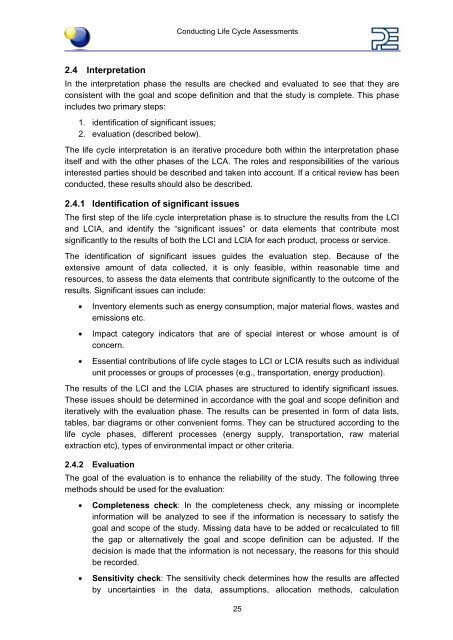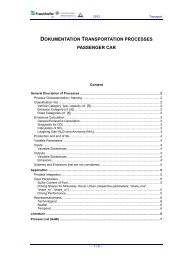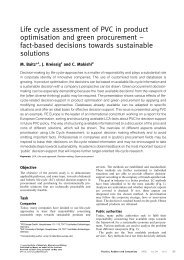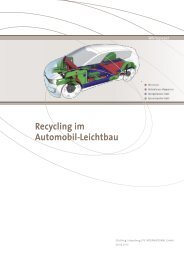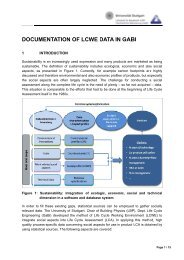GaBi Paper Clip Tutorial - GaBi Software
GaBi Paper Clip Tutorial - GaBi Software
GaBi Paper Clip Tutorial - GaBi Software
You also want an ePaper? Increase the reach of your titles
YUMPU automatically turns print PDFs into web optimized ePapers that Google loves.
2.4 Interpretation<br />
Conducting Life Cycle Assessments<br />
In the interpretation phase the results are checked and evaluated to see that they are<br />
consistent with the goal and scope definition and that the study is complete. This phase<br />
includes two primary steps:<br />
1. identification of significant issues;<br />
2. evaluation (described below).<br />
The life cycle interpretation is an iterative procedure both within the interpretation phase<br />
itself and with the other phases of the LCA. The roles and responsibilities of the various<br />
interested parties should be described and taken into account. If a critical review has been<br />
conducted, these results should also be described.<br />
2.4.1 Identification of significant issues<br />
The first step of the life cycle interpretation phase is to structure the results from the LCI<br />
and LCIA, and identify the “significant issues” or data elements that contribute most<br />
significantly to the results of both the LCI and LCIA for each product, process or service.<br />
The identification of significant issues guides the evaluation step. Because of the<br />
extensive amount of data collected, it is only feasible, within reasonable time and<br />
resources, to assess the data elements that contribute significantly to the outcome of the<br />
results. Significant issues can include:<br />
Inventory elements such as energy consumption, major material flows, wastes and<br />
emissions etc.<br />
Impact category indicators that are of special interest or whose amount is of<br />
concern.<br />
Essential contributions of life cycle stages to LCI or LCIA results such as individual<br />
unit processes or groups of processes (e.g., transportation, energy production).<br />
The results of the LCI and the LCIA phases are structured to identify significant issues.<br />
These issues should be determined in accordance with the goal and scope definition and<br />
iteratively with the evaluation phase. The results can be presented in form of data lists,<br />
tables, bar diagrams or other convenient forms. They can be structured according to the<br />
life cycle phases, different processes (energy supply, transportation, raw material<br />
extraction etc), types of environmental impact or other criteria.<br />
2.4.2 Evaluation<br />
The goal of the evaluation is to enhance the reliability of the study. The following three<br />
methods should be used for the evaluation:<br />
Completeness check: In the completeness check, any missing or incomplete<br />
information will be analyzed to see if the information is necessary to satisfy the<br />
goal and scope of the study. Missing data have to be added or recalculated to fill<br />
the gap or alternatively the goal and scope definition can be adjusted. If the<br />
decision is made that the information is not necessary, the reasons for this should<br />
be recorded.<br />
Sensitivity check: The sensitivity check determines how the results are affected<br />
by uncertainties in the data, assumptions, allocation methods, calculation<br />
25


